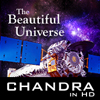CXC Home | Search | Help | Image Use Policy | Latest Images | Privacy | Accessibility | Glossary | Q&A
High definition views of Chandra's exciting science

Subscribe and automatically download fresh audio/video content: View content online by clicking the "View Podcast" links below (requires QuickTime 7.0 or other H.264-compliant video viewer. If videos do not play, right click or control click on the link to download the file to your hard drive & then open). Or, subscribe to the podcast using a program such as iTunes or ipodder with the podcast RSS/XML web address (listed below).
Video Listing
Quick Look: NASA Telescopes Work Out Black Hole's Snack Schedule (08-14-2024)
A team of researchers have made important headway in understanding how — and when — a supermassive black hole obtains and then consumes material.
- Related Links:
-- NASA Telescopes Work Out Black Hole's Snack Schedule

A team of researchers have made important headway in understanding how — and when — a supermassive black hole obtains and then consumes material.
- Dowload Video Podcast (26.3 MB, Runtime: 0:45)
- Related Links:
-- NASA Telescopes Work Out Black Hole's Snack Schedule

Tour: NASA Telescopes Work Out Black Hole's Snack Schedule (08-14-2024)
A team of researchers have made important headway in understanding how — and when — a supermassive black hole obtains and then consumes material.
- Related Links:
-- NASA Telescopes Work Out Black Hole's Snack Schedule

A team of researchers have made important headway in understanding how — and when — a supermassive black hole obtains and then consumes material.
- Dowload Video Podcast (175.5 MB, Runtime: 2:55)
- With closed-captions (at YouTube)
- Listen to Audio Only
- Transcript
- Related Links:
-- NASA Telescopes Work Out Black Hole's Snack Schedule

Quick Look: 25 Images to Celebrate Chandra's 25th Anniversary (07-22-2024)
To celebrate the 25th anniversary of its launch, NASA's Chandra X-ray Observatory is releasing 25 never-before-seen views of a wide range of cosmic objects.
- Related Links:
-- 25 Images to Celebrate Chandra's 25th Anniversary

To celebrate the 25th anniversary of its launch, NASA's Chandra X-ray Observatory is releasing 25 never-before-seen views of a wide range of cosmic objects.
- Dowload Video Podcast (57.5 MB, Runtime: 0:45)
- Related Links:
-- 25 Images to Celebrate Chandra's 25th Anniversary

Tour: 25 Images to Celebrate Chandra's 25th Anniversary (07-22-2024)
To celebrate the 25th anniversary of its launch, NASA's Chandra X-ray Observatory is releasing 25 never-before-seen views of a wide range of cosmic objects.
- Related Links:
-- 25 Images to Celebrate NASA's Chandra 25th Anniversary

To celebrate the 25th anniversary of its launch, NASA's Chandra X-ray Observatory is releasing 25 never-before-seen views of a wide range of cosmic objects.
- Dowload Video Podcast (236.6 MB, Runtime: 3:10)
- With closed-captions (at YouTube)
- Listen to Audio Only
- Transcript
- Related Links:
-- 25 Images to Celebrate NASA's Chandra 25th Anniversary

Quick Look: Take a Summer Road Trip Through Images with NASA's Chandra, Webb (07-11-2024)
It's time to take a cosmic road trip using light as the highway and visit four stunning destinations across space. The vehicles for this space get-away are NASA's Chandra X-ray Observatory and James Webb Space Telescope.
- Related Links:
-- Take a Summer Road Trip Through Images with NASA's Chandra, Webb

It's time to take a cosmic road trip using light as the highway and visit four stunning destinations across space. The vehicles for this space get-away are NASA's Chandra X-ray Observatory and James Webb Space Telescope.
- Dowload Video Podcast (58 MB, Runtime: 0:45)
- Related Links:
-- Take a Summer Road Trip Through Images with NASA's Chandra, Webb

Please note: These podcasts include artist illustrations and conceptual animations in addition to astronomical data.


